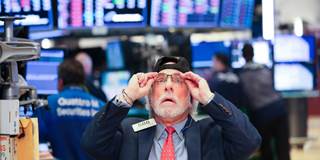Many mistaken assumptions about the 2008 financial crisis remain in circulation. As long as policymakers believe the crisis was rooted in the housing bubble rather than human psychology, another crisis will be inevitable.
BERKELEY – The 2008 financial crisis and subsequent recession left the Global North 10% poorer than it otherwise would have been, based on 2005 forecasts. For those hoping to understand this episode better, I have long recommended four books, in particular: Manias, Panics, and Crashes, by the twentieth-century economist Charles P. Kindleberger; This Time Is Different, by Carmen M. Reinhart and Kenneth S. Rogoff of Harvard University; The Shifts and the Shocks, by the Financial Times economics commentator Martin Wolf; and Hall of Mirrors, by my University of California, Berkeley, colleague Barry Eichengreen.
Now, I want to add a fifth book to the list: A Crisis of Beliefs: Investor Psychology and Financial Fragility, by the economists Nicola Gennaioli and Andrei Shleifer. (Full disclosure: Shleifer was my roommate in college and graduate school; to this day, I credit him with whatever positive skills or reputation I may have.)
A Crisis of Beliefs is important for three reasons. First, it offers a welcome rejoinder to those who argue that the past decade was an unavoidable result of the housing bubble in the United States. Many experts still claim that the bubble’s deflation triggered the financial crisis. But the fact is that the bubble had already deflated substantially before the crisis erupted.

BERKELEY – The 2008 financial crisis and subsequent recession left the Global North 10% poorer than it otherwise would have been, based on 2005 forecasts. For those hoping to understand this episode better, I have long recommended four books, in particular: Manias, Panics, and Crashes, by the twentieth-century economist Charles P. Kindleberger; This Time Is Different, by Carmen M. Reinhart and Kenneth S. Rogoff of Harvard University; The Shifts and the Shocks, by the Financial Times economics commentator Martin Wolf; and Hall of Mirrors, by my University of California, Berkeley, colleague Barry Eichengreen.
Now, I want to add a fifth book to the list: A Crisis of Beliefs: Investor Psychology and Financial Fragility, by the economists Nicola Gennaioli and Andrei Shleifer. (Full disclosure: Shleifer was my roommate in college and graduate school; to this day, I credit him with whatever positive skills or reputation I may have.)
A Crisis of Beliefs is important for three reasons. First, it offers a welcome rejoinder to those who argue that the past decade was an unavoidable result of the housing bubble in the United States. Many experts still claim that the bubble’s deflation triggered the financial crisis. But the fact is that the bubble had already deflated substantially before the crisis erupted.